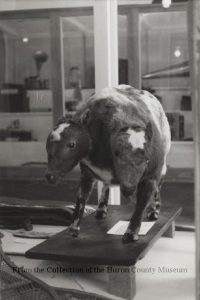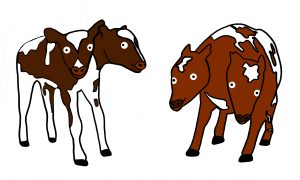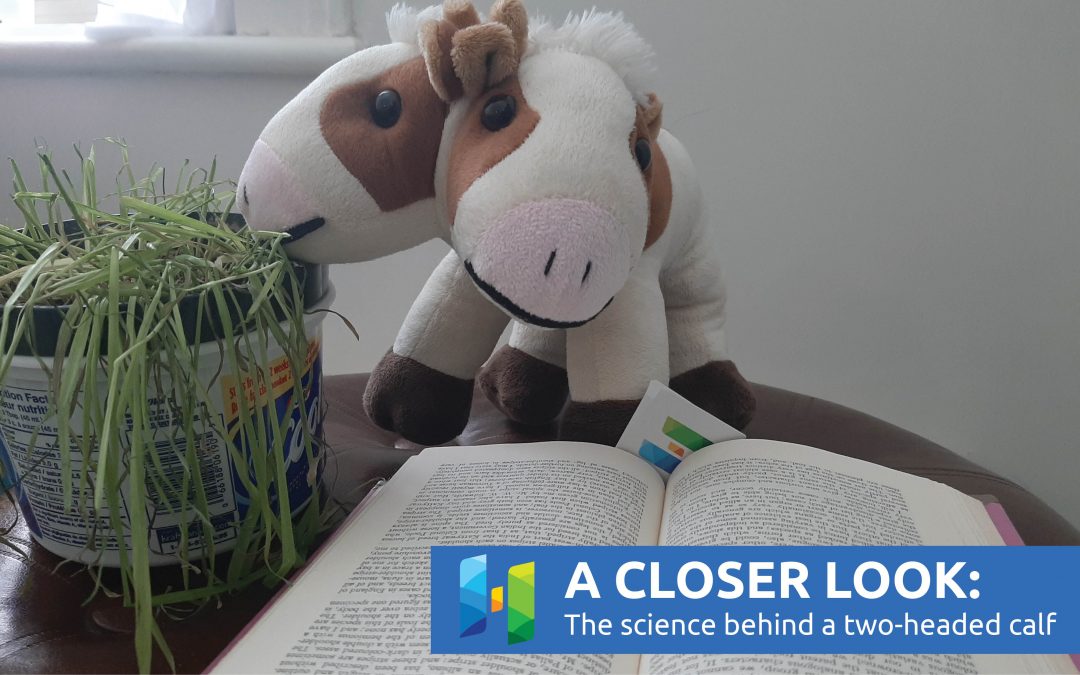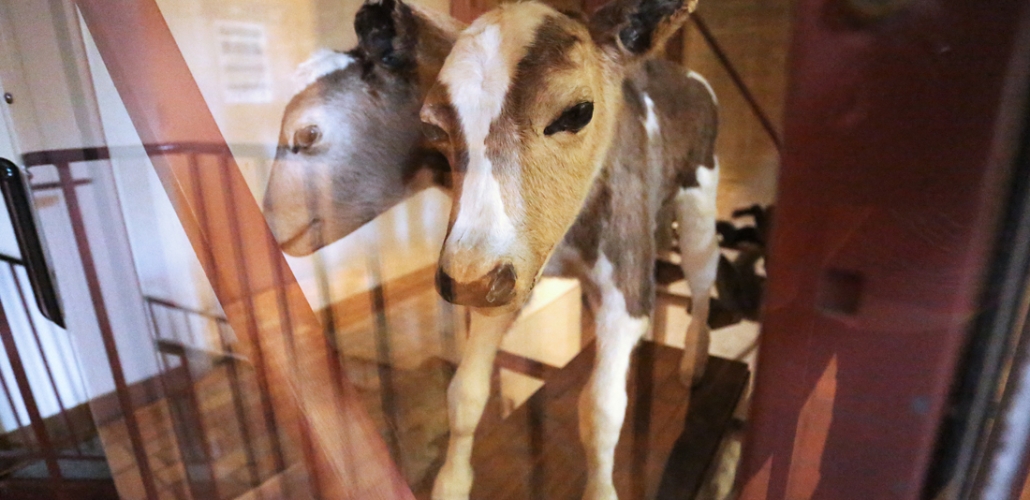Take a closer look at the Huron County Museum & Historic Gaol and its collections as staff share stories about some well-known and some not-so-well-known features, artifacts, and more. The Huron County Museum’s two-headed calves are perhaps our most recognizable artifacts, and attract a lot of questions from visitors.
Although familiar with the two-headed calves’ history, Acting Senior Curator Sinead Cox wanted to know more about the genetic causes of polycephaly: the condition of a single animal having more than one head. How and why does this rare phenomenon happen?
Sinead talked to veterinarian Dr. Alaina Macdonald to find out more from an expert on animal health.
Sinead Cox: Can you share a little bit about yourself and your professional background?
Dr. Alaina Macdonald: I graduated from the Ontario Veterinary College in 2019 and have worked in mixed animal practice since graduation. I have always carried an appreciation for agriculture, and love being able to help animals and their humans live healthy lives. My newest interest is learning how to incorporate aspects of human, animal and environmental health in problem solving of worldwide issues.
SC: The Huron County Museum has two taxidermied calves in our collection with two heads and two tails. How on earth does an animal end up having two heads?
AM: The rare development of two-headed offspring is directly related to the formation of identical twin embryos early in the pregnancy. This phenomenon is seen in reptiles, birds, amphibians, and mammals (including humans). In fact, much of what we know about two-headed animals can be better understood by studying human conjoined twins, as it is a very similar process! When an egg becomes fertilized, a tiny embryo is formed. Occasionally, the embryo divides in a way which produces a second embryo with the same genetic material. This process must occur in a very delicate and specific balance of gene expression and the correct environmental conditions. Most often, it occurs before day 10 of gestation, and the result is two identical twins. Rarely, this process occurs late (around day 13-14), and the process of mitosis (cell division) is interrupted, resulting in two identical embryos which did not fully divide. Some literature indicates that polycephaly is due to a disruption of the primitive streak, which is an organized embryonic structure of cells present towards the second week of gestation.
SC: Could there be environmental factors that would cause this?
AM: No one knows the exact mechanism behind the abnormal splitting of the embryo. Trace mineral deficiencies and environmental factors such as increasing water temperatures and toxin exposure have been implicated in some species, but there are likely many causes. Anything that disrupts that delicate timing of gene expression (including random chance) can cause abnormalities in embryonic development.
SC: How often does this happen?
AM: There is no way to truly know how often this occurs, as this event would generally result in the early loss of pregnancy, and those pregnancies often are undetected. Indeed, it is exceptionally rare for the embryo to develop into a full-term fetus, and to survive the length of the gestation. It is not considered an inherited trait, because the offspring almost never live to reproductive age. In humans, development of identical twins is not considered genetic, which would also indicate that polycephaly in animals and conjoined twins in humans is a “chance” event with possible implications for environmental factors.
 SC: Wow. That really puts into perspective how rare and special these calves are. Both of the calves at the museum were born in the early twentieth century. Is polycephaly more likely to happen now than in the past?
SC: Wow. That really puts into perspective how rare and special these calves are. Both of the calves at the museum were born in the early twentieth century. Is polycephaly more likely to happen now than in the past?
AM: Interestingly, fossil evidence indicates that polycephaly has been present in some species for the last 150 million years!
SC: I always think it’s sort of lovely that our two-headed calves are so loved and live on forever at the museum, when they had very short lives (less than a day). Why doesn’t a two-headed calf live very long?
AM: Calves with two heads often have many other congenital abnormalities. For example, the cardiovascular, neural and digestive systems may be malformed, which makes it nearly impossible for the calf to carry out normal vital functions. A live birth of any two-headed animal is rare, and many of them die shortly after birth. There was one calf who survived with intensive care for several months, which is likely the longest any polycephalic calf has lived.
SC: Have you ever seen any two-headed animals in your work life?
AM: No, I have never seen a two-headed animal myself. I am sure it comes as quite a surprise to everyone involved! There is some evidence to suggest that the many-headed creatures described in Greek mythology may have been inspired by polycephalic animals observed during those times.
SC: What is the strangest or most unexpected thing you have seen as a veterinarian?
AM: I have seen some animals in strange predicaments; from the kitten who ate pieces of a couch, to the dog with a piece of tooth embedded in his leg and the cat with a fishhook in his lip, all had something to teach me about veterinary medicine. The most startling moment of my career was when I was standing beside a horse, taking her temperature, and as we stood looking out the barn door the farm was struck by lighting! Everyone was fine, but the farmer needed to replace his electric fence. Nature always has a way of surprising us!
 Thank you to Dr. Alaina Macdonald for answering our questions and making us appreciate the uniqueness of these unforgettable artifacts even more! For more information on polycephaly, Alaina suggests these references:
Thank you to Dr. Alaina Macdonald for answering our questions and making us appreciate the uniqueness of these unforgettable artifacts even more! For more information on polycephaly, Alaina suggests these references:
https://pubmed.ncbi.nlm.nih.gov/15278382/
http://www.bbc.com/earth/story/20161018-the-two-headed-creatures-that-may-have-inspired-hydra
FURTHER READING:



